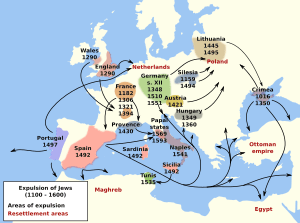History of the Jews in Europe facts for kids
Jews have lived in Europe for thousands of years. Their lives and how they got along with rulers and other people changed a lot over time. In the ancient Roman Republic and Roman Empire, there were Jewish people who had different rights and relationships with the Romans. After big wars between Romans and Jews in the first and second centuries, and the destruction of their Temple, many Jews were forced to leave Palestine. This made the number of Jews in Europe (and North Africa and Asia) much larger.
Contents
Life in the Middle Ages
During the Middle Ages, things were often hard for Jewish people. As Christianity spread, so did anti-Jewish feelings. Jews were often not allowed to mix with Christians or work in most jobs. They were often made to live in special parts of cities called ghettos.
However, Jews were allowed to do some jobs that Christians were not. For example, they could lend money to people and charge interest. This was important for economies but was seen as wrong for Christians. This helped some Jews become wealthy. But it also led to more anger and unfair treatment against them.

Finding New Homes
Eventually, some Jews found a welcome home in Poland. The Polish king created the Statute of Kalisz to protect them. For instance, Christians could not easily accuse Jews of crimes, which had often led to unfair punishments. Many Christians, however, did not like this protection. Because of this, many Jews, known as Ashkenazim, moved to Eastern Europe.
In Spain and Portugal, during the time of Muslim rule (called Al-Andalus), Jews were generally accepted. They could not be part of the government, but they lived peacefully. After Christians took back control of the Iberian Peninsula, Jews were rejected and treated badly if they stayed. Some found safety in the Ottoman Empire. This empire was quite open to Jews and Christians. It let them have their own courts and laws, as long as they paid taxes and followed Ottoman rule.
Changes in Modern Times
After the Renaissance and the Early Modern Period, Jews slowly became more accepted. They were allowed to live openly as Jews in more and more countries. After the French Revolution, France and other European countries under Napoleon I started new laws. These laws aimed to separate religion from public life. They also wanted to treat Jews more like regular citizens. This meant Jews could believe what they wanted privately but still be part of the community.
Some Jews chose to give up their religion or join the larger community. For example, some became Christians, like the father of British Prime Minister Benjamin Disraeli. However, many European countries still had rules against Jews until the 1800s and 1900s. They were banned from certain jobs or from holding public office. Despite this, many Jews became famous scientists or thinkers. People like Karl Marx, Sigmund Freud, and Albert Einstein became very important. Just a hundred years before, this would have been impossible.
World War II and the Holocaust
In modern times, with republics and constitutional monarchies forming in Europe, conditions for Jews were much better. Some chose to move to the United States and other American countries, like Argentina. The United States eventually had the largest Jewish population outside of the Russian Empire.
After Poland became independent again, it had Europe's largest Jewish population, about 3,000,000 people. The Soviet Union, formed in 1922, had almost as many.
When Adolf Hitler came to power in Germany, more Jews started to leave. They went to Western European countries and the United States. The Germans even supported this at first, as they did not want Jews in German-controlled areas. More Jews also moved to Palestine. This land had been taken from the Ottoman Turks by the United Kingdom in 1917. Many hoped to create a Jewish homeland there. Hitler supported this migration for a while. However, the British were worried because more Jews meant conflicts with the local Arabs. These Arabs did not want Jewish immigration, and there were several violent fights between them and British troops.

With World War II, the German armies controlled most of Europe. They began sending Jews to the east. Eventually, they started a policy of mass murder known as the Holocaust. After 1942, almost all Jews under German control were sent to Eastern Europe. There, they were killed or forced to work until they died. By the end of the war in 1945, about two-thirds of the Jewish people in Europe had been killed. Only the Jewish communities in Albania, Denmark, Sweden, Switzerland, Spain, Portugal, Britain, and Ireland were mostly safe. Those in Italy, Yugoslavia, and Romania were less affected.
After the war, many surviving Jews moved to the United States and Palestine. In Palestine, Israel was created in 1948 as a country for Jews. This meant Europe lost most of its Jewish population, and the United States became the country with the most Jews. Later, unfair treatment in Communist Poland and other countries also caused more Jews to leave. Today, out of the 3,000,000 Jews in Poland before the war, fewer than 3,000 remain. However, in France, the United Kingdom, and Russia, there are still many Jewish communities, similar to before the war.
Images for kids
-
Sultan Bayezid II sent Kemal Reis to save the Arabs and Sephardic Jews of Spain from the Spanish Inquisition in 1492, and granted them permission to settle in the Ottoman Empire








